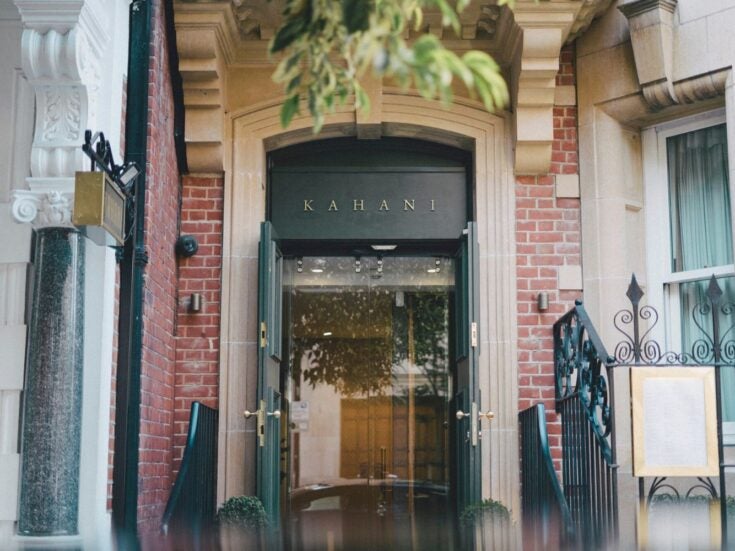
The restaurant that was once Edinburgh’s first Michelin-starred establishment is now an institution, writes Andrew Harris
Choose life. Choose a job. Choose a career… opines the opening page of Irvine Welsh’s highly acclaimed novel Trainspotting, set in Edinburgh’s port district, Leith, which in 1993 came with an uncompromising reputation, after decades of post-war deprivation. I chose lunch at Restaurant Martin Wishart on the Leith waterfront, where one of Scotland’s most celebrated chefs presides over an outpost of culinary excellence. No sign of Spud or Sick-Boy. Just a couple of swans gliding gracefully around outside the large picture window.
The restaurant was Edinburgh’s first recipient of a Michelin star in 2001, an accolade it has held onto every year since, accruing along with Trainspotting, a certain cult status. Wishart’s decision to locate his solo venture there places him in the vanguard of what has been a transformative process for the area. From Miami, where he now lives, Welsh also remains engaged with the promulgation of Leith, where he was born, as an edgy counterpoint to touristy Edinburgh.
One of the aspects of Wishart’s world to make itself immediately apparent is an unashamedly French orientation, which, as I am a fellow Francophile, parachutes me directly into my comfort zone. His wife, Cecile, is French, though brought up in Mexico, and it’s amidst the French culinary arts that his craft was honed. Personally, I have no problem in conceding that the French intuitively embrace the kitchen, the table and everything in between, in a manner that simply isn’t recognisable in the UK. If only they’d also accept that they should leave the music to us, there’d be the perfect symbiotic relationship. We could even listen to the radio when driving across France foraging for food, without that awful Europop cat wailing.
Driving across France was something Martin Wishart did at an early age in an old camper van after his attempts to contact onetime three Michelin starred chef, Marc Meneau, were ignored. In a demonstration of the determination and dedication that has helped sustain his career, he just turned up on Meneau’s doorstep in backwoods Burgundy, the kind of place where the local populace has one-pint blood to seven pints béchamel sauce, coursing through their veins. Meneau, it transpired, was a fully paid-up member of the Shouty Chefs Association, and the stay wasn’t a prolonged one, but it initiated a sequence of sojourns in some very prestigious kitchens, where a burgeoning talent was burnished by the will to succeed.
After working with luminaries from Albert Roux and Michel Roux Jnr, to Marco Pierre White and John Burton-Race, Wishart eventually found himself back in his home city, sitting on the dock of the bay in Leith. Any shouting from now on (I don’t think there’s a lot, actually), would be done by him in a restaurant with his name outside.
The original space was considerably smaller and less opulent than the elegant dining room it has expanded into today. The naturally lit, and immediately inviting space, feels so perfectly on point, it’s as if they had those Feng Shui furniture movers in. Although I’m not sure if Leith does Feng Shui, or it still thinks it’s something from the local takeaway that Begbie might have shoved in somebody’s face.
A style best described as clean-lined contemporary with a nod toward 1960s chic, complemented by views straight out onto the water, conspires to create an extremely alluring first impression. As does the very welcome second impression conveyed by Mathieu, the sommelier from Amiens, with Wishart now for over a decade. All issues of a noble grape variety swiftly and seamlessly dealt with.
Aside from the lunch and nicely concise, a la carte menus, there are six course and eight-course tasting menus, both available in vegetarian format, and all with a rigorous emphasis on seasonality and provenance. Wishart is well aware that the Scottish game and seafood always in demand from kitchens across the world is close to hand, and some of the absolute best find its way into his Leith larder.
An amuse bouche of beetroot meringue concealing a horseradish filling, followed by a first course of cepe veloute with warm chicken liver parfait and roasted cobnuts, indicates immediately and incontrovertibly, how high the gastronomic bar is set. A solitary ravioli of partridge, accompanied by trompette mushrooms in a beautifully balanced truffle cream, followed by monkfish so fresh it could have introduced itself, unleashes a cuisine that is both unafraid of powerful flavours, and capable of the artistry and subtlety with which to present them. Desserts encompassed a dish of sweet buttermilk mousse with fennel sorbet, sorrel parfait and granny smith, that reaffirmed via its deft juxtaposing of differing sweetness, the dexterity of the skillset on display.
This is without any doubt, a very refined, accomplished, and sublimely enjoyable dining experience. How this restaurant has maintained its Michelin star all this time is no mystery. Why there hasn’t been a second one, could be. Wishart, who now has three other venues, one of which on Loch Lomond also has a star, articulates his raison d’etre, thus: ‘classically French, proudly Scottish, and simply delicious’. I’m not remotely inclined to take issue with any of that.







